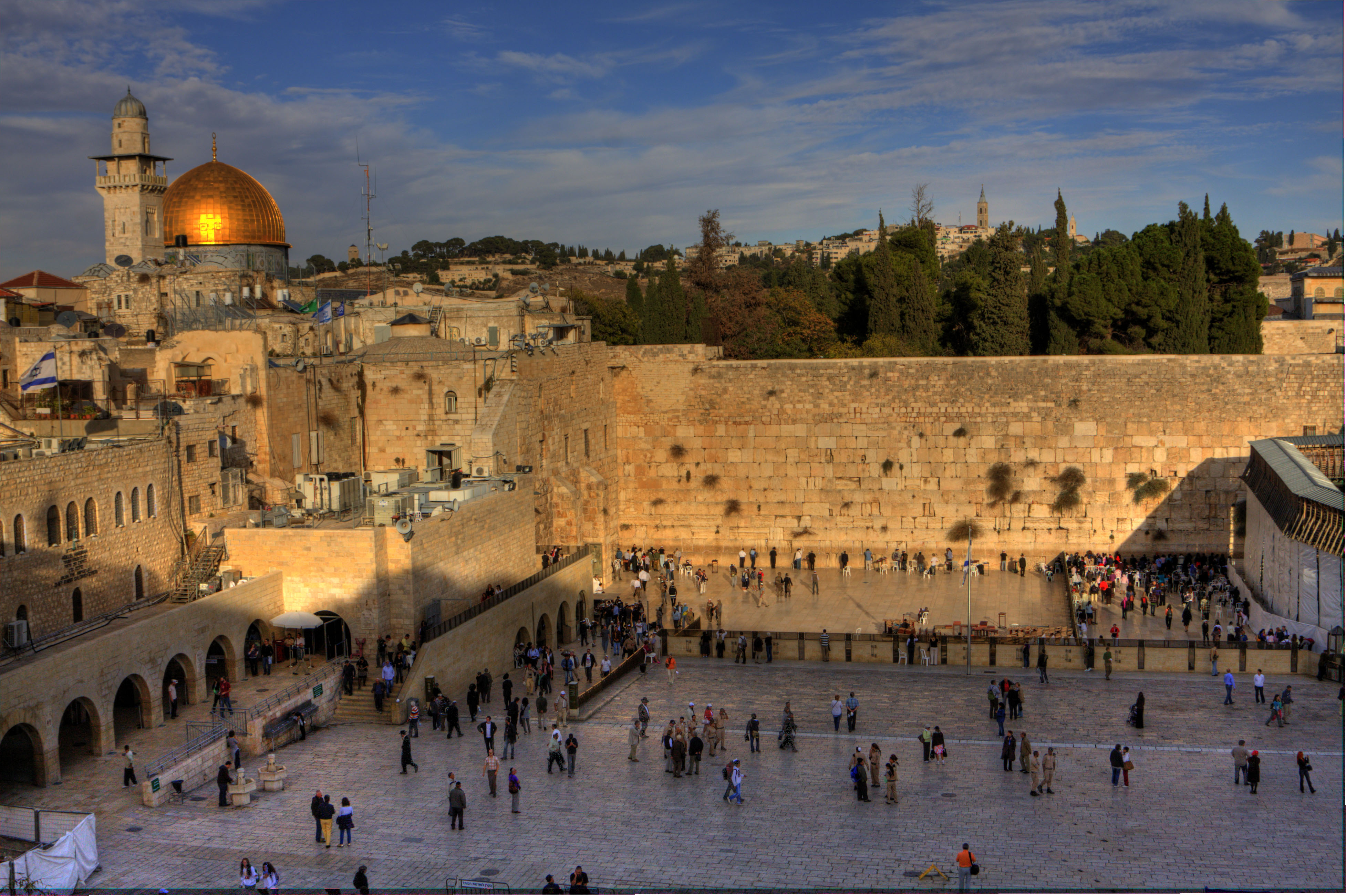This is known in Hebrew as the Kotel Ha-Ma'aravi. It was formerly called the "Wailing Wall" by European observers because for centuries, Jews came here to mourn the loss of their temple. It is the holiest of Jewish sites, a remnant of the monumental Herodian retaining wall that encloses and still supports the Temple Mount.
For centuries the wall stood 18m (59 ft.) above the level of the earth and 27m (89 ft.) long, towering over a narrow alley 3.6m (12 ft.) wide that could accommodate only a few hundred densely packed worshipers. In 1967, immediately after the Six-Day War, the Israelis bulldozed the Moors Quarter facing the wall to create a plaza that could accommodate tens of thousands of pilgrims. They also made the wall about 2m (7 ft.) higher by digging down when building the plaza and exposing two more tiers of the Wall's ashlars (squared stones) that had been buried by accumulated debris for centuries. At the southern end of the Wall, away from the area reserved for prayer and worship, archaeologists since 1967 have uncovered spectacular remains from various periods.
At the prayer section of the Western Wall, grass grows out of the upper cracks. The lower cracks of the chalky, yellow-white blocks have been stuffed with bits of paper containing prayers. Orthodox Jews can be seen standing at the wall, chanting and swaying. Visitors of all religions are welcome to approach the Wall and to pray silently beside it (both Pope John Paul II and the Dalai Lama have come to pray here as pilgrims). Men who would like to go to the Wall must wear a hat or take a head covering, at no cost, from a box beside the entrance to the prayer area. Women may borrow shawls and short-skirt coverings, but it is best to come with a longish skirt and long sleeves. A separate section at the extreme right of the Western Wall is reserved for women, who are not allowed into the men's section in keeping with Orthodox Jewish tradition. On some days, you may encounter a number of professional beggars who can make a visit to the Wall difficult. Giving charity at a time of pilgrimage is an ancient Jewish tradition, but many travelers find it best to avoid the Western Wall charity seekers and instead make a donation to an organized charity at a later time. Services are held here daily; no photography or smoking is permitted on the Sabbath and some Jewish holidays.
The exposed lower courses of the Western Wall are composed of enormous rectangular ashlars, or carefully carved stones, each dressed only with the recessed borders typical of Herodian-era stonework. The sides of these monumental ashlars have been carved with such precision that they rest perfectly against and on top of each other, without mortar. Over the millennia, the fine straight lines and margins of some of the ashlars have eroded away.
The Wall was built by King Herod just before the time of Jesus and is part of a structure that retains the western part of Temple Mount and the vast, artificial ceremonial plaza Herod created on the Temple Mount itself. These retaining (as well as defensive) walls surround the western, southern, and eastern sides of the Temple Mount. The largest of the ashlars is 3.6m (12 ft.) high and 14m (46 ft.) long and weighs approximately 400 tons. According to Josephus, the Roman Jewish historian, construction of the walls took 11 years, during which time it rained in Jerusalem only at night, so as not to interfere with the workers' progress.
In the right-hand corner of the women's prayer area, beside a protruding newer building, you can see an area of the Wall composed of small, rough stones. These stones block a fragment of a Herodian-era door to the Temple Mount, today called Barclay's Gate after the 19th-century American consul who first identified it. To the south of the earthen ramp leading up the Temple Mount, you can see a fragment of large stonework protruding out of the Wall. This is Robinson's Arch, all that remains of a great stairway, set on arches, which passed over the busy market street at the foot of the Western Wall, and led directly into the Great Stoa on the southern side of Temple Mount.
The Western Wall is actually much higher and longer than the portion you can readily see today. For an idea of how high the original construction was, and what the level of the earth was 2,000 years ago, enter the doorway located between the men's restrooms and the public telephones on the plaza's northern side. Both men and women can enter free upon request, Sunday, Tuesday, and Wednesday from 8:30am to 3pm, Monday and Thursday from 12:30 to 3pm, and on Friday from 8:30am to noon; closed Saturday. Enter the dark labyrinth of vaults and chambers, pitfalls (now rendered safe by lamps, grates, and barriers), and passages. Inside, the continuation of the Wall is clearly visible. Shafts have been sunk along the Wall to show its true depth. The arches in this artificial cavern date from various eras, ranging from Herodian (37 B.C.-A.D. 70) to Crusader (1100-1244). The platform is behind a prayer room filled with Orthodox worshipers. The prayer room is off-limits to women, except in the viewing area.
A special walk into excavated tunnels alongside the Western Wall can be arranged by making an appointment with the Western Wall Heritage Foundation (tel. 02/627-1333).
Note: This information was accurate when it was published, but can change without notice. Please be sure to confirm all rates and details directly with the companies in question before planning your trip.









